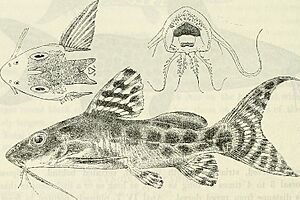Synodontis ornatipinnis facts for kids
Quick facts for kids Synodontis ornatipinnis |
|
|---|---|
 |
|
| Conservation status | |
| Scientific classification | |
| Genus: |
Synodontis
|
| Species: |
ornatipinnis
|
The Synodontis ornatipinnis, also known as the barfin synodontis, is a cool type of upside-down catfish. It lives in the Congo Basin in countries like the Democratic Republic of the Congo and Zambia. A scientist named George Albert Boulenger first described this fish in 1899. He found it near Mbandaka on the Congo River. The name ornatipinnis means "fancy fins" because of its pretty markings!
Contents
What Does It Look Like?
Like other Synodontis fish, the barfin synodontis has a strong, bony head. This bony part goes all the way back to its first fin on its back. It also has a special bony bump on its head called a humeral process. This bump's shape helps scientists tell different Synodontis species apart. For the barfin synodontis, this bump is a bit rough and pointed.
Its Whiskers and Fins
This fish has three pairs of barbels, which are like whiskers. One pair is on its upper jaw, and two pairs are on its lower jaw. The upper whiskers are long and straight, reaching a bit past its head. The outer lower whiskers are almost twice as long as the inner ones and have small branches.
The fins on its back and chest have stiff, bony spines at the front. The spine on its back fin is about two-thirds to three-quarters the length of its head. It's slightly curved and smooth on the front, but rough on the back. The rest of this fin has seven soft, branching rays. The chest fin spine is a little shorter than its head and is rough on both sides.
The adipose fin (a small, fleshy fin near the tail) is three to four times longer than it is deep. The anal fin, which is on its underside, has four unbranched and seven branched rays. It's somewhat pointed at the front. The tail fin is deeply split, shaped like a crescent moon, with the top part being larger than the bottom.
Its Teeth
All Synodontis fish have a special pad of teeth on the very front of their upper jaw. These teeth are short and shaped like chisels, arranged in several rows. In the barfin synodontis, this tooth pad is short and wide.
On its lower jaw, the teeth are attached to flexible, stalk-like structures. They are described as "s-shaped" or "hooked." The number of teeth on the lower jaw helps tell different species apart. The barfin synodontis usually has about 20 to 26 teeth on its lower jaw.
Color and Size
The barfin synodontis has a yellowish or light olive color on its back. Its belly is white. Its fins are yellow and have black spots that form bands, making them look very decorative!
This fish can grow up to 40 centimetres (16 in) long. Generally, female Synodontis fish tend to be a bit larger than males of the same age.
Habitat and Life Cycle
The barfin synodontis is found all over central Africa in the wild. People in these areas sometimes catch and eat this fish.
Reproduction
Scientists don't know much about how most Synodontis species reproduce. We do know that females can carry many eggs. It's thought that these fish probably lay their eggs during the rainy season, which is usually between July and October. During this time, pairs of fish might swim together when they are spawning. Young fish grow very quickly in their first year, and then their growth slows down as they get older.


